CONTROLLINGAS AMANAGEMENTFUNCTION Controlling is that process of

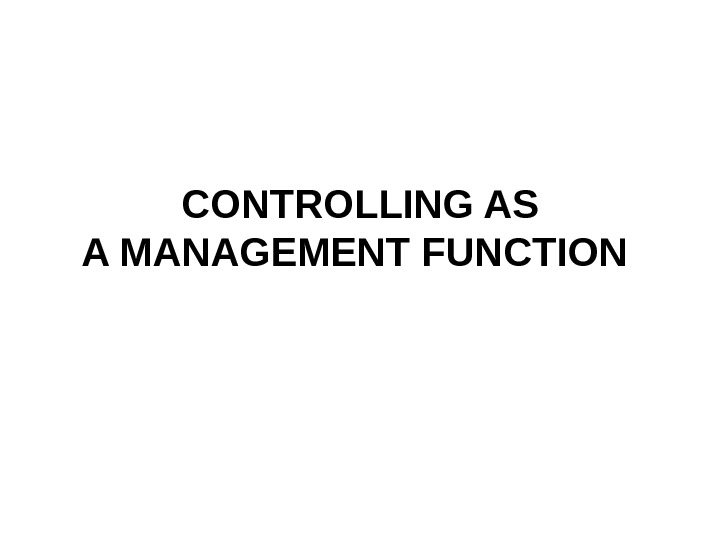

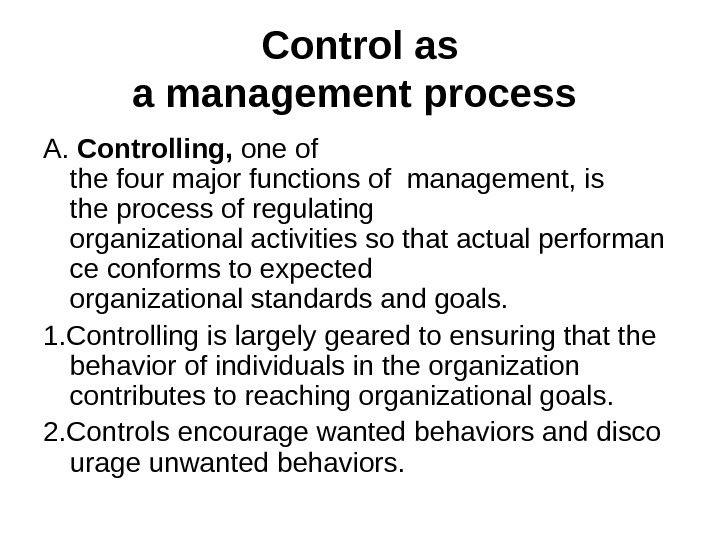

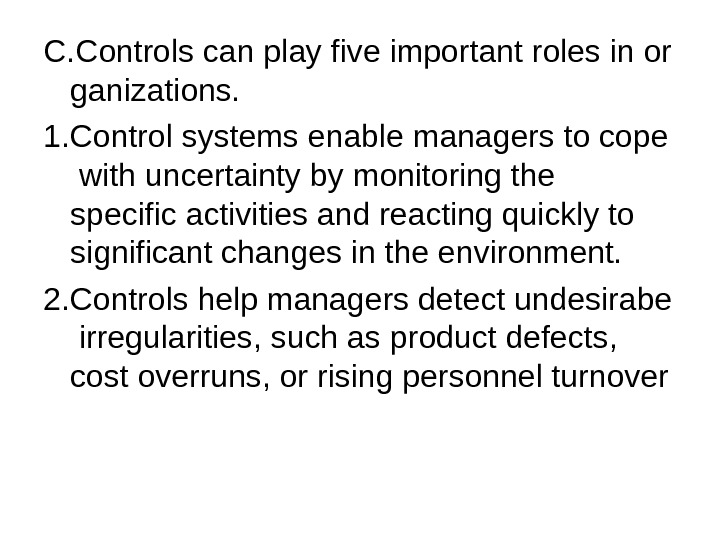
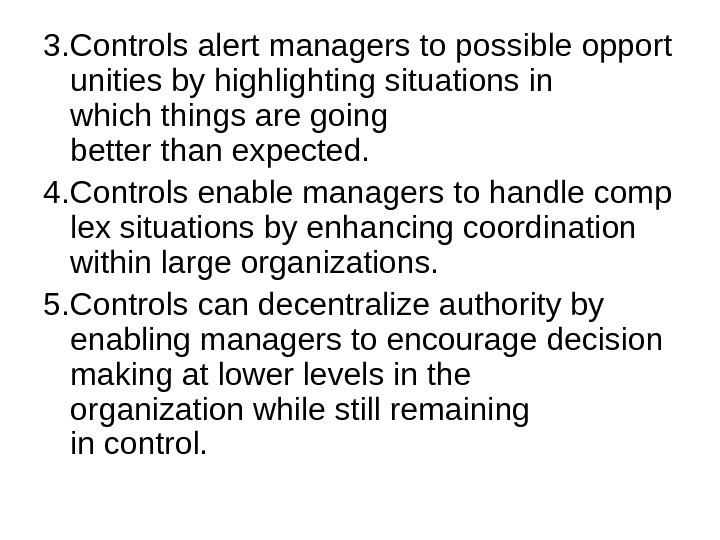
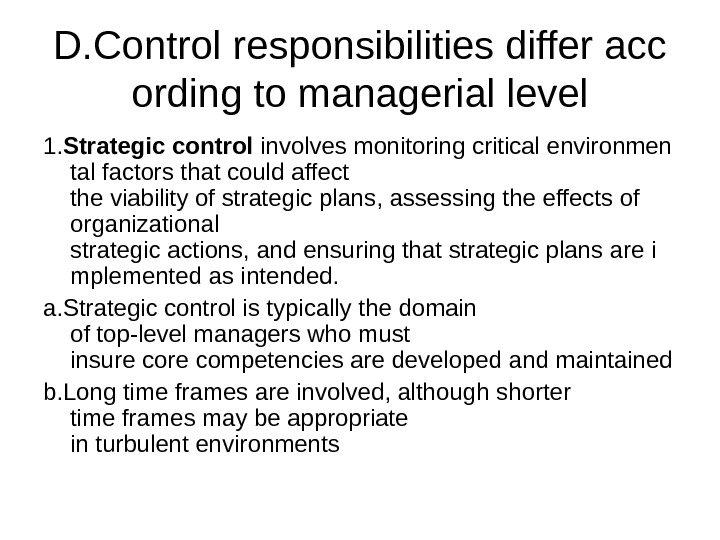



controllingas_amanagementfunction.ppt
- Размер: 47 Кб
- Количество слайдов: 10
Описание презентации CONTROLLINGAS AMANAGEMENTFUNCTION Controlling is that process of по слайдам
 CONTROLLINGAS AMANAGEMENTFUNCTION
CONTROLLINGAS AMANAGEMENTFUNCTION
 Controlling is that process of regulating organizational activities so that actual performa ce conforms to expected organizational goals and standards. W hile interrelated with all of the other management functions, a special relationship exists between the planning f unction of management and controlling. Planning, essentially, is the deciding of goals and objectives and the means of reachin g them. Controlling lets manager tell if the organization is on track for goal achievement, and if not, why not. A well-developed plan should provide benchmarks that can be used in the control process
Controlling is that process of regulating organizational activities so that actual performa ce conforms to expected organizational goals and standards. W hile interrelated with all of the other management functions, a special relationship exists between the planning f unction of management and controlling. Planning, essentially, is the deciding of goals and objectives and the means of reachin g them. Controlling lets manager tell if the organization is on track for goal achievement, and if not, why not. A well-developed plan should provide benchmarks that can be used in the control process
 Controlas amanagementprocess A. Controlling, one of the four major functions of management, is the process of regulating organizational activities so that actual performan ce conforms to expected organizational standards and goals. 1. Controlling is largely geared to ensuring that the behavior of individuals in the organization contributes to reaching organizational goals. 2. Controls encourage wanted behaviors and disco urage unwanted behaviors.
Controlas amanagementprocess A. Controlling, one of the four major functions of management, is the process of regulating organizational activities so that actual performan ce conforms to expected organizational standards and goals. 1. Controlling is largely geared to ensuring that the behavior of individuals in the organization contributes to reaching organizational goals. 2. Controls encourage wanted behaviors and disco urage unwanted behaviors.
 B. A controlsystem is a set of mechanisms that are designed to i ncrease the probability of meeting organizational standards and goals
B. A controlsystem is a set of mechanisms that are designed to i ncrease the probability of meeting organizational standards and goals
 C. Controls can play five important roles in or ganizations. 1. Control systems enable managers to cope with uncertainty by monitoring the specific activities and reacting quickly to significant changes in the environment. 2. Controls help managers detect undesirabe irregularities, such as product defects, cost overruns, or rising personnel turnover
C. Controls can play five important roles in or ganizations. 1. Control systems enable managers to cope with uncertainty by monitoring the specific activities and reacting quickly to significant changes in the environment. 2. Controls help managers detect undesirabe irregularities, such as product defects, cost overruns, or rising personnel turnover
 3. Controls alert managers to possible opport unities by highlighting situations in which things are going better than expected. 4. Controls enable managers to handle comp lex situations by enhancing coordination within large organizations. 5. Controls can decentralize authority by enabling managers to encourage decision making at lower levels in the organization while still remaining in control.
3. Controls alert managers to possible opport unities by highlighting situations in which things are going better than expected. 4. Controls enable managers to handle comp lex situations by enhancing coordination within large organizations. 5. Controls can decentralize authority by enabling managers to encourage decision making at lower levels in the organization while still remaining in control.
 D. Control responsibilities differ acc ording to managerial level 1. Strategiccontrol involves monitoring critical environmen tal factors that could affect the viability of strategic plans, assessing the effects of organizational strategic actions, and ensuring that strategic plans are i mplemented as intended. a. Strategic control is typically the domain of top-level managers who must insure competencies are developed and maintained b. Long time frames are involved, although shorter time frames may be appropriate in turbulent environments
D. Control responsibilities differ acc ording to managerial level 1. Strategiccontrol involves monitoring critical environmen tal factors that could affect the viability of strategic plans, assessing the effects of organizational strategic actions, and ensuring that strategic plans are i mplemented as intended. a. Strategic control is typically the domain of top-level managers who must insure competencies are developed and maintained b. Long time frames are involved, although shorter time frames may be appropriate in turbulent environments
 2. Tacticalcontrol focuses on assessing the im plementation of tactical plans at departmental levels, monitoring associated pe riodic results, and taking corrective action as necessary. a. Tactical control is primarily under the direction of middle managers, but top-level managers may at times get involved. b. Time frames are periodic, involving weekly or monthly reporting cycles. c. Tactical control involves department-level obje ctives programs, andbudgets.
2. Tacticalcontrol focuses on assessing the im plementation of tactical plans at departmental levels, monitoring associated pe riodic results, and taking corrective action as necessary. a. Tactical control is primarily under the direction of middle managers, but top-level managers may at times get involved. b. Time frames are periodic, involving weekly or monthly reporting cycles. c. Tactical control involves department-level obje ctives programs, andbudgets.
 3. Operationalcontrol involves overseeing t he implementation of operating plans, monitoring day-to-day res ults, and taking corrective action when required. a. Operational control is the responsibility of lower-level managers. b. Control is a day-to-day process. c. The concern is with schedules, budgets, ru les, and specific outputs of individuals
3. Operationalcontrol involves overseeing t he implementation of operating plans, monitoring day-to-day res ults, and taking corrective action when required. a. Operational control is the responsibility of lower-level managers. b. Control is a day-to-day process. c. The concern is with schedules, budgets, ru les, and specific outputs of individuals


